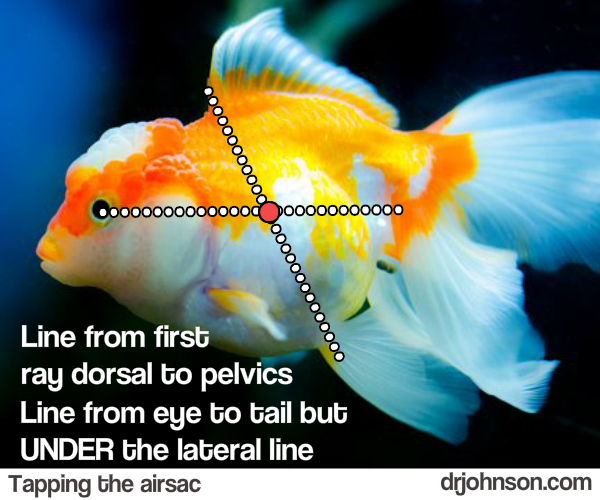Air Sac Pneumocentesis
Air Sac Pneumocentesis is an important part of the management of Floater Syndrome wherein a fish becomes inverted and floats helplessly on the surface. Many factors contribute to this condition but the most common denominator is a proportional correlation (relationship) between higher Nitrate levels in the system and higher incidence of “Floater” and “Flipover” in the collection.
Floaters should be ‘reduced’ by a procedure called Air Sac Pneumocentesis. In this process, the air sac is defined within the body of the fish and is drained of air without risk to any important vascular structure or digestive entity.
A sterile 22-gauge needle on a 3-ml syringe is used to extract the air, but hitting the air sac without damaging another structure is of paramount importance. The needle is introduced perpendicular (90o) to the side of the fish to a depth of approximately half the fishes’ thickness. If you cannot pull back on the syringe’s plunger, you are NOT in the airsac. It is almost impossible to miss the air sac when you use the following landmarks.

The anatomical landmarks in Goldfish are as follows:
- Longitudinally [vertically] you can define your landmarks by observation of the first ray of the dorsal fin. Coming straight down the side of the fish from this ray to the pelvic fins, you define your vertical axis.
- Latitudinally, [horizontally] you come across at a point in line with the eye and slightly below the lateral line where it crosses your vertical axis.
- Insert the needle at this intersection and withdraw as much air as you can. In large fish, 3-6 ml of air can be expected.
The fish will have lost all its buoyancy when returned to the tank. The fish will set on the bottom of the tank lethargically. There should be very little bleeding from the needle stick.
After Air Sac Pneumocentesis
If the fish is still inverted, give it time. The air sac will usually refill within twenty-four hours. If the fish refills completely, it will be floating upside down again the following morning. Hopefully, the fish will not refill completely and will be swimming normally the following day. Some people are putting Baytril injectable into the air bladders after they’re emptied.
If the case resists this treatment and returns to an overly buoyant and inverted condition, you will need to repeat the Air Sac Pneumocentesis and then perform and Quartz Implant Coeleotomy.






